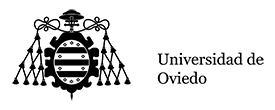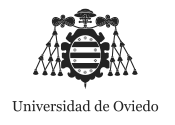Estudia
- Artes y humanidades
- Ciencias
- Ciencias de la salud
- Ciencias sociales y jurídicas
-
Ingeniería y arquitectura
- Doble Grado en Ingeniería Civil e Ingeniería de los Recursos Mineros y Energéticos
- Doble Grado en Ingeniería en Tecnologías y Servicios de Telecomunicación / Grado en Ciencia e Ingeniería de Datos
- Doble Grado en Ingeniería Informática del Software / Grado en Matemáticas
- Doble Grado en Ingeniería Informática en Tecnologías de la Información / Grado en Ciencia e Ingeniería de Datos
- Grado en Ciencia e Ingeniería de Datos
- Grado en Ingeniería Civil
- Grado en Ingeniería de los Recursos Mineros y Energéticos
- Grado en Ingeniería de Organización Industrial
- Grado en Ingeniería de Tecnologías Industriales
- Grado en Ingeniería de Tecnologías Mineras
- Grado en Ingeniería Eléctrica
- Bachelor´s Degree in Industrial Electronics and Automatics Engineering
- Grado en Ingeniería en Geomática
- Grado en Ingeniería en Tecnologías y Servicios de Telecomunicación
- Grado en Ingeniería Forestal y del Medio Natural
- Grado en Ingeniería Forestal y del Medio Natural (En extinción)
- Grado en Ingeniería Informática del Software
- Grado en Ingeniería Informática en Tecnologías de la Información
- Grado en Ingeniería Mecánica
- Grado en Ingeniería Química
- Grado en Ingeniería Química Industrial
- Grado en Marina
- Grado en Náutica y Transporte Marítimo
- Información, acceso y becas
Álgebra Lineal
- Prácticas de Laboratorio (9 Hours)
- Prácticas de Aula/Semina (21 Hours)
- Clases Expositivas (28 Hours)
This course (Linear algebra), belonging to Mathematical Foundations, is placed on the module of Basic Formation of the Bachelor´s Degrees in Engineeringof Mining and Energy Resources, in Forest and Environmental Engineering, in Geomatic and Topographic Engineering and in Civil Engineering.
The aim is to provide the student with the basic tools of linear algebra to solve problems in science and engineering.
The student should have studied basic mathematics in secondary education (in the case of Spanish students, the courses Matemáticas I and II).
Competencies BOE:
Capacity of solving mathematical problems posed in engineering. Use of mathematical tools (Linear Algebra, Geometry, Differential Geometry, Differential and Integral Calculus, Differential equations and PDE, Numerical Methods, Numeric Algorithmic, Statistics and Optimization) applied to problems solving in engineering.
General and transversal competencies:
Gradual development of abstract thinking and synthesis. Search skills, analysis and management of information to transform it in knowledge. Proper writing and oral skills. Team work, leadership and auto-critics. Use of mathematical tools applied to problems solving in engineering.
General and transversal competences for the Bachelor's Degree in Civil Engineering:
Scientific-technical skills for the exercise of the profession of Technical Engineer of Public Works and knowledge of the functions of advice, analysis, design, calculation, project, construction, maintenance, conservation and exploitation. Capacity to maintain and conserve the hydraulic and energy resources, in their field.
Skills and learning outcome:
RA1: Using the basic operations and properties of real and complex numbers.
RA2: Using the basic items of Linear Algebra: systems of linear equations, vector spaces, linear mappings and matrices.
RA3: Using the metric properties in Euclidean spaces.
RA4: Finding Eigenvalues and Eigenvectors of matrices and linear operators, applying these concepts to diagonalizing.
RA5: Solving geometrical problems in two and three dimensions.
RA6: Using the basic items of Linear algebra for differential equations.
T1. Real and complex numbers.
1.1 Real numbers. Operations and properties.
1.2 Complex numbers. Operations and properties.
T2. Matrices and systems of linear equations.
2.1. Matrices and basic properties. Determinants.
2.2. Solving systems of linear equations by Gauss method, applying it in calculating matrix inverses.
T3. Vector spaces.
3.1. Vector spaces, definition and examples.
3.2. Linear combinations, independence. Dimension, basis and coordinates.
3.3. Vector subspaces. Sums and intersections of vector subspaces.
T4. Linear transformations.
4.1. Definition and properties.
4.2. Matrix of a linear map relative to basis. Change of basis and matrices.
4.3. Kernel and image spaces. Classification: injective, surjective, bijective.
T5. Diagonalizable linear operators and matrices.
5.1. Eigenvalues and Eigenvectors.
5.2. Diagonalizable linear operators and matrices.
T6. Euclidean spaces.
6.1. Definition and properties.
6.2. Inner product and norm.
6.3. Metric properties.
6.4. Orthogonality.
6.5. The case of symmetric operators.
T7. Basic elements of the Cartesian geometry.
7.1. Euclidean geometry. Coordinate systems.
7.2. Euclidean plane and space.
T8. An introduction to differential equations.
8.1. Basic concepts.
8.2. Solving systems of differential equations.
Labs:
1- Getting started with MATLAB (1,5 hours).
2.- Matrices (1,5 hours).
3.- Systems of linear equations.Vector spaces (2 hours).
4.- Linear maps (2 hours).
5.- Linear operators. Applications to matrices (2 hours).
To achieve the aforementioned skills, the student needs to perform in-class and distance learning work.
The in-class sessions are divided into:
-Expositive classes: In these classes the lecturer will explain the theoretical part of the contents of the course.
-Seminars: Most seminars will be devoted to apply the techniques explained in expositive classes to problems.
-Lab classes: Problems will be solved by means of appropriate software.
Exceptionally, if sanitary conditions require it, distance learning activities may be included. In which case, students will be properly informed about changes.
The timing shown here is guiding and it could be altered depending on teaching need.
Themes | Hours | Expositive classesand exams | Seminars | Lab classes | Total | Team work | Individual work | Total |
Real and complex numbers | 8.5 | 1.5 | 1.5 | 1 | 4 | 1.5 | 3 | 4.5 |
Matrices and systems of linear equations | 16.5 | 2 | 2 | 2 | 6 | 3.5 | 7 | 10.5 |
Vector spaces | 21.5 | 5 | 3.5 | 1 | 9.5 | 4 | 8 | 12 |
Linear transformations | 27.5 | 5,5 | 3.5 | 2 | 11 | 5.5 | 11 | 16.5 |
Diagonalizable linear operators and matrices | 21 | 3 | 3 | 2 | 8 | 4 | 9 | 13 |
Euclidean spaces | 25 | 5 | 4.5 | 1 | 10.5 | 4.5 | 10 | 14.5 |
Cartesian geometry | 15 | 3 | 1.5 | 4.5 | 3.5 | 7 | 10.5 | |
An introduction to Differential equations | 15 | 3 | 1.5 | 4.5 | 3.5 | 7 | 10.5 | |
Total | 150 | 28 | 21 | 9 | 58 | 30 | 62 | 92 |
TYPES | Hours | % | Total | |
In-class activities | Expositive classes and exams | 28 | 18,67% | 58 (38,67%) |
Seminars | 21 | 14% | ||
Lab classes | 9 | 6% | ||
Distance learning activities | Team work | 30 | 20% | 92 (61,33%) |
Individual work | 62 | 41,33% | ||
Total | 150 | |||
The final mark (up to ten points) will be based on:
i) A written exam. The mark will account for 50% of the final mark.
ii) Exercises in Seminars will account for 30% of the final mark.
iii) Labs classes will account for 10% of the final mark. The evaluation will consist in a continuous assessment. The mark will be kept in June and July test calls.
vi) Personal work in class sessions will account for 10% of the final mark.
v) In June and July test calls there will be an exam which will account 90% of the final mark. The 10% of labs classes mark will be kept in June and July test calls.
It is necessary to obtain a minimum of 5 points in the final mark to pass the course.
Exceptionally, if sanitary conditions require it, distance assessment methods may be included. In which case, students will be properly informed about changes.
Bibliography:
Axler, S. Linear Algebra done right. Springer, New York, 1995
Hefferon, J. Linear Algebra. http://joshua.smcvt.edu/linearalgebra, 2008
Jacob, B. Linear Algebra. NY: W.H. Freeman, New York, 1990
Lang, S. Introduction to Linear Algebra. Second edition. NY: Springer-Verlag, New York, 1986.
Noble, B. and Daniel, J. W. Applied Linear Algebra. Third Edition. Englewood Cliffs, NJ: Prentice Hall, 1988.
Strang, G. Introduction to Linear Algebra. 4th ed. Wellesley, MA, 2009.
Strang, G. Linear Algebra and Its Applications. Third Edition. San Diego, CA: Harcourt Brace Jovanovich, 1988.

